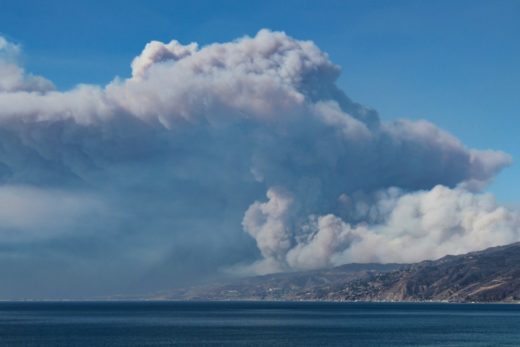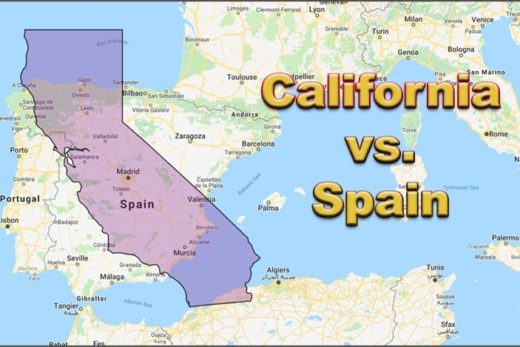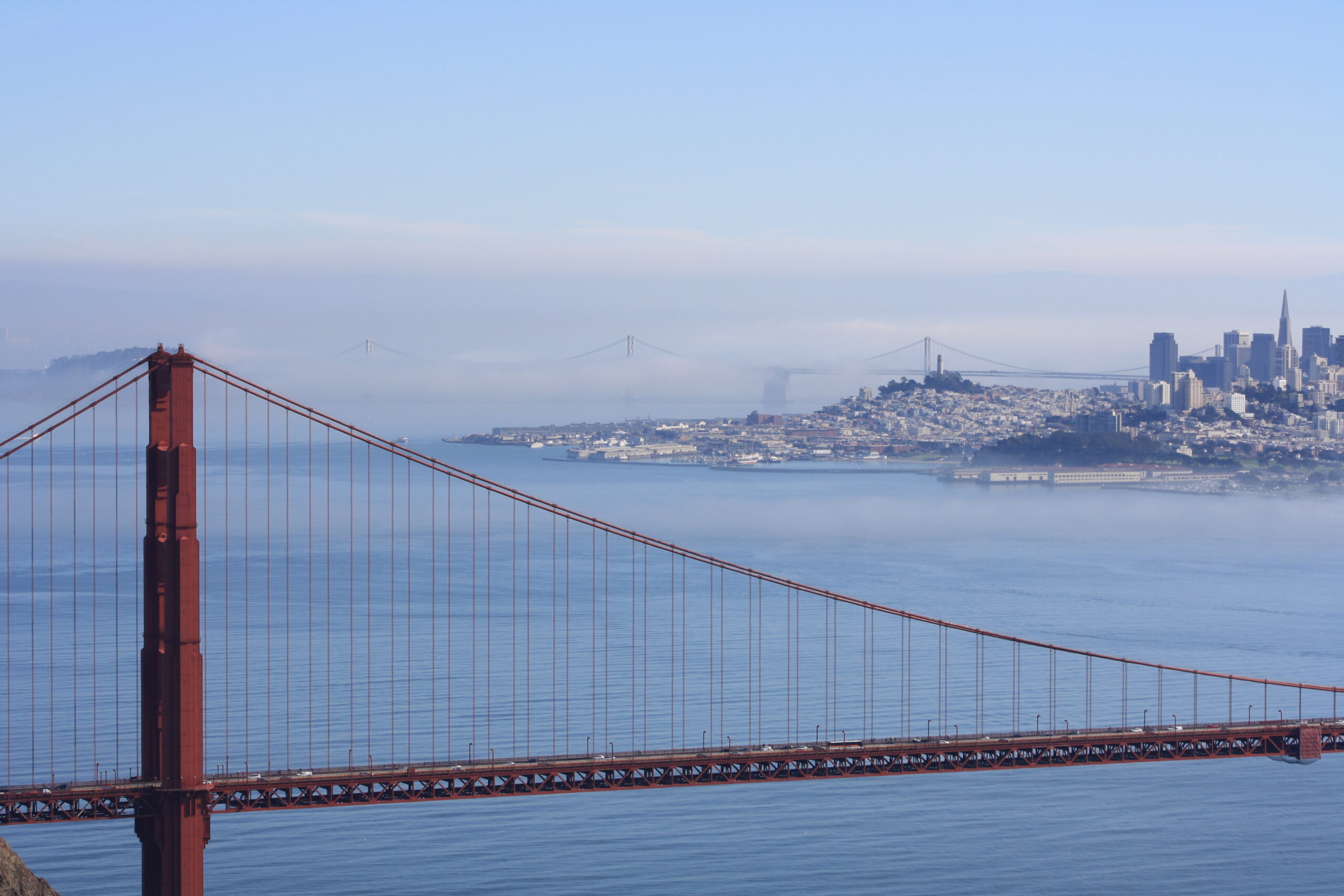A few months ago, in the spring of 2020, we shared stories about our oddly inverted 2019-2020 rainy season and the longer-term climate changes impacting California. As we slid into what started as routinely stagnant and unremarkable summer weather patterns, we hoped to turn our attention toward the diversity of stories that combine to make our state’s geography so golden. But nature had other plans and we are now forced to focus on what has become – for weeks – a top national and global news story in a year already filled with tragedy: two unprecedented late summer weather patterns and the resulting fire storms have rampaged across California and surrounding states, terrorizing residents, and leaving catastrophic paths of death and destruction.

The stories and images and data continue to resemble science fiction rather than anything we thought we could experience, even after the warning signs from previous years that have been outlined in our publication and this project. As of this writing, more than 20 out-of-control wildfires have been burning for weeks that include the first, third, and fourth largest wildfires in state history. By the middle of September, 2020, more landscape burned (well over 3 million acres, more than 3% of the entire state) compared to any other year as we just entered into our traditional fire season. (By mid-October, more than 4 million acres (4% of the state) was scorched.) Though California fires raged from Oregon to the Mexican border and from the coast to the Nevada border, neighboring western states were also burning, roughly doubling the total charred acreage. Entire towns have been leveled in Washington and Oregon as 1 out of 10 residents in Oregon were under evacuation orders. Heroic firefighters and other public servants and volunteers have been exhausted trying to establish a sense of order while surrounded by an atmosphere that feels as out-of-control as in any time in state history. The apocalypse red and orange skies of smoke that blanketed our state have sickened millions. How did we get here so quickly and how will we get out of this mess?

We have dedicated a lot of time and space in our publication and on this web site to research that might help us understand the fires we are experiencing. We know that four of the big culprits are climate change, forest and wildland management, the introduction of nonnative invasive species, and our reckless encroachment into wild places. (You will find a more detailed essay about forest management after the end of this story.) But it is our unforgivable historical ignorance about the natural systems and cycles that surround us in Mediterranean environments that are adapted to and even sculpted by occasional fires, which brings these factors together to create the most deadly and disastrous fire storms.

We know that our cool, wet winters nurture growth, but are followed by long, dry summers that can dehydrate the hardiest plant communities and challenge them to survive, even in average years, until the first rains of autumn. The iconic climate that helped make California powerful and famous has partnered with climate change, and is now threatening to destroy us. The curse of the wildlands urban interface (known as WUI) is that we dared long-established natural forces by ignoring them to develop and expand our at-risk communities, forcing nature to teach us painful lessons about who is in charge.

This summer’s nightmare started last winter when parts of central and northern California (such as the Bay Area) suffered from another record drought that included the entire January-February period that normally marks the peak of the rainy season, and the first February ever with no recorded precipitation. By spring, expanses of northern and central California were left with only about half of their average total precipitation and far less than even southern California received for the season. We walked you through this geographically inverted rainy season in a previous story on this web page.

Summer began relatively mild, but there were hints of trouble to our east. A strong and stubborn high pressure system anchored over the desert southwest and occasionally wobbled toward southeastern California during July. This blocked out most monsoon moisture and compressed the air to produce record heat in Arizona and New Mexico that encroached into California’s southeastern deserts. By the end of July, much of Arizona (including Phoenix) had broken several high temperature records, including the hottest month ever recorded and – by far – the greatest number of days with temperatures above 110. Their heat continued into August, but the ominous high pressure system began to expand and migrate west toward California and Nevada.

California’s deserts had already been baking, but the high center was strengthening and its compressionally-heated air masses were nudging toward the Golden State. Inland temperatures sizzled until Death Valley topped out at 130 degrees in mid August. This approached the hottest temperature (134) ever recorded there, but it could be the hottest temperature ever confirmed on Earth at an official weather station with a reliable thermometer (see an earlier story on this web site). By this time, record high temperatures were being recorded around the state, particularly at inland stations closer to the center of upper level high pressure.

The strength and position of this high pressure system was remarkable, not just because it clamped a lid on the already heated air masses that plagued California. The clockwise motion of air spinning around the high connected with tropical moisture and disturbances west of Mexico, driving them from south-to-north off and along the California coast. (This monsoon-style moisture train usually flows from Mexico up into the desert southwest during late summer as a smaller high pressure center normally positions closer to the four corners region.)

Moist, unstable air masses gradually veered toward the northeast around the massive high and ahead of a counterclockwise spinning low pressure system off the Pacific Northwest coast. Batches of subtropical moisture, exhausted tropical disturbances, and instability flowed up the coast and inland into central and northern California. The bands of moisture had just enough energy to trigger spectacular electrical storms that trained off the ocean toward the coast (where summer thunderstorms are almost unheard of in the normally stable summer air masses) and over inland mountains. But the mostly high-based cumulonimbus clouds often didn’t drop enough rainfall to snuff out the hundreds of fires sparked by thousands of lightning strikes that lit up mountain slopes from the coast to Nevada. Last winter’s drought would conspire with the unusual “dry” lightning and the intense heat wave to produce the most destructive series of fires in California history.

Eventually, the powerful high pressure system that helped produce these conflagrations weakened and backed off. A relatively cooler onshore flow gave especially northern Californians a brief chance to catch up with the numerous fires.







But, another powerful high pressure quickly built over the state by early September before the fires could be controlled. As forecast, it eventually anchored just inland over Nevada and wobbled over California and Oregon, eventually squeezing up against a deep, early-season upper level low dropping down the east side of the Rocky Mountains. Intense pressure gradients between the two systems compressed very dry air masses and sent them toward the coast as an offshore flow that was further compressed down mountain slopes, heated, and dried. National Weather Service warnings had become reality.






These unusually early-season Diablo winds in northern California and Santa Ana-like winds in southern California rejuvenated the existing fires and fanned new fires like blowtorches. It is notable that firefighters in Oregon used “blowtorch” to describe “powerful winds from the east that blasted fires down mountain slopes to incinerate entire towns.” These accounts from Oregon are very familiar to Californians during autumn, but this was only Labor Day weekend.

Aloft, the center of the towering, high pressure air mass even breached historic thresholds of 600 decameters (or 6,000m) altitude. This measures the height of 500mb pressure (roughly halfway through a column of air in our atmosphere, that midpoint averaging around 5,600m altitude (about 18,000 feet)). Temperatures soared over 100 degrees along the coasts from San Diego to San Francisco.

A few miles inland, scores of records were broken, and some of them were the highest temperatures ever recorded for those locations. In southern California, the hottest temperatures ever recorded west of the low deserts included Woodland Hills at 121 F (highest ever in L.A. County) and Chino and Fillmore at 120. Downtown L.A. peaked at 111 degrees, while numerous coastal valley locations also breached 110. Just across the border, coastal Tijuana, Mexico, reported 109 F. Farther north, Solvang and San Luis Obispo breached 120 degrees. Stockton heated to 111 and Napa hit 120. UC Berkeley Lab, at about 888 feet elevation, experienced one day with a high of 108 degrees F and an overnight low of 87. Calfire crews and local firefighters were outgunned by nature as fires exploded and tore through plant communities and human communities. All of this leaves us with scenes of unprecedented devastation.

Besides the communities and homes that have burned throughout the west, an area larger than some eastern states has been scorched. Entire national forests were shut down to protect visitors from getting trapped after so many were rescued, while the less fortunate never made it out of more remote landscapes. It would take weeks or more to find the remains of all the missing victims.


Meanwhile, it is not surprising that the measured air quality had never been so bad across the entire state for such a long period. Layers of smoke particles that had already interfered with the shorter-wavelengths of the visible spectrum (such as blues) are efficient in selectively scattering the longer-wavelength (closer to 0.7 micrometers) yellows, oranges, and reds of ROYGBIV toward the surface (known as Mie scattering), illuminating our skies in those colors. As multiple smoke plumes with particles of various sizes towered up through different layers of atmosphere, they encountered wind shear that spread them in different directions until smoke blanketed the entire state. The layers of smoke clouds grew thicker until forecasters had trouble predicting daytime temperatures that were more than five degrees cooler than under a smokeless sky. The smoke produced condensation nuclei that mixed with the marine layer to create thicker haze and smoky fogs near the coast. Subdued daytime high temperatures inland resulted in weaker afternoon temperature and pressure gradients that further calmed winds during the day.

The stagnant, capping high pressure system that followed the record heat wave resulted in gentle pressure gradients with relatively calm winds away from the fires that oscillated from slightly offshore to slightly onshore for days, swirling and settling the accumulating smoke. Besides the falling ash, smaller particulates lodged into our lungs. The eerie red and orange haze may have lasting effects on Californians’ health, just as the destruction of our ecosystems and landscapes will have lasting effects on plant communities, wildlife, and anyone who attempts to connect with nature in California. However, health officials’ research suggests that most of us will recover relatively rapidly compared to the slower process of succession that heals scorched ecosystems over many years. By the middle of September, a low pressure system approaching the Pacific Northwest would eventually usher in some refreshing breezes off the Pacific that pushed much of the smoke away and to the east of northern California. Traces of that smoke were noticed and measured across the continent all the way over the North Atlantic (see the NASA images at the end of this story).

We will mourn the victims and use names to remember the largest fires (such as the August Complex that burned through September) in history. But every one of these latest worst “natural” disasters challenges us again to rethink our relationships with nature and to better understand the natural systems and cycles that determine whether and how we will survive and live and thrive in the Golden State. Our most recent jargon-gone-popular term, wildlands-urban interface (WUI), must also refer to the sky and the weather and climate that we all observe and interact with every day. So, we might not know what the coming autumn and winter have in store (except for the inevitable Diablo and Santa Ana winds and then the debris flows that will pour out of freshly-burned landscapes during winter storms), but we know that nature won’t be waiting for us to reconnect. We will continue our attempts to reconnect with you through our project and this web site. The following essay about forest management is one example.




Our Tragic Comedy of Errors Goes up in Flames: An Additional Essay on Forest Management in 2020
It is necessary to pause here and respond again to the media and political frenzy that has erupted over the management of California’s forests. The story is complicated and there is plenty of finger-pointing to be done. But the research always directs us back to some fundamental historic problems caused by our national obsession with chasing short-term profits and solutions that have cost us lives and fortunes in the long run.

More than a century ago, the nation’s seemingly endless western forests were viewed by many as inexhaustible resources to provide building materials and other timber products. Our national forests were often valued by the tree and the acre as dense tree farms to be cyclically logged and replanted with the fastest-growing, most valuable species in homogeneous forests that produced the greatest short-term profits, sometimes at the expense of multiple uses. It was quickly recognized that fires cut in to those profits. One of the primary reasons for establishing and funding what became the U.S. Forest Service was to organize efforts to extinguish fires as soon as they erupted. Little was known about the long-term consequences of these policies, but we now know that they disrupted thousands of years of natural evolution and succession that had produced diverse, resilient forests with rich mixes of species adapted to occasional fires. Recently, we have realized the unfortunate results of this colossal experiment that was accidentally launched during the 1800s.

Too often lost in these debates is how many of our trees grow on private lands in a state where only slightly more than half of the forests were managed by the U.S. Forest Service and more than 90% of our original forests have been logged at least once. Responsible, local, private timber companies know that sustainable logging results in healthier forests that retain their long-term value. But some of these smaller companies were consumed (especially in the late 1900s) by distant absentee Wall Street financiers and larger multinational corporations to pay off debts and gain quick quarterly profits. Too often, long-term forest sustainability was a second thought. This led to more reckless overlogging and mismanagement that we are still living with.

During recent decades, California has responded to these historic debacles with controlled burns and other forest thinning policies over relatively small areas. But, due mainly to lack of funding and pushback from local communities, ecotourist industries, air quality management districts, and other multiple users who are temporarily inconvenienced and negatively impacted by these efforts, scientists estimate that less than 10% of our forests are being properly managed with our more informed policies. Meanwhile, U.S. Forest Service funding for these healthier forest programs has been cut as federal budgets are depleted in attempts to extinguish conflagrations that are consuming communities and threatening lives. These short-sighted funding policies have led some to sarcastically rename the National Forest Service the “National Fire Service”.

Recently, local communities have been successfully organizing to decrease fire risks, in cooperation with the state and USFS, through the California Fire Safe Council. This is a big development in many of those wildland-urban interface (WUI) communities, where they have been thinning trees and brush and creating defensible spaces within and around their neighborhoods. These efforts even include annual property inspections with requirements that residents maintain defensible spaces around their properties. Note these excerpts from their web pages:
“The California Department of Forestry and Fire Protection (CDF) formed the California Fire Safe Council with the intent of seeing that local fire safe councils were formed with the single charge of educating the local public about fire abatement practices that can save their homes in the event of a fire.”
“Fire Safe Councils throughout California educate homeowners about community wildfire preparedness activities while working with local fire officials to design and implement projects that increase the wildfire survivability of their communities. Many Fire Safe Councils have successfully implemented such projects as hazardous-fuel-reduction projects, Community Wildfire Protection Planning, and homeowner training.”

You can see that, in recent years, many Californians have been actively and often aggressively implementing policies that decrease fire risks in their communities. But, within landscapes riddled with poorly regulated developments encroaching into fire-prone ecosystems, accumulated historical mismanagement, a political atmosphere that rewards short-sighted budget cutting, and accelerating climate change, it has been too little, too late for too many communities. We face an uphill battle even with aggressive, all-out, no-holds-barred course corrections, due to the synergy of other factors that we have repeatedly outlined in our publication and this web site.

This is also because so many California fires start and burn in grassland, coastal sage scrub, chaparral, and woodland plant communities that will always grow dense and ripe for fire, but don’t involve forests of trees. Add aggressive, nonnative, invasive species (such as cheatgrass), that quickly dehydrate into flammable matchsticks from early summer until the next rainy season. Add other species that attack, weaken, and destroy our trees during unprecedented droughts, such as the bark beetles that feed on our conifers, and the mistakenly introduced Goldspotted Oak Borer that is now chewing through our Black Oaks and Canyon Live Oaks in some woodlands. Add climate change that is sucking the moisture out of plants and soils and you have the perfect science-fiction-like reality that we are living through.

Oversimplified stories about how Native Americans managed some California landscapes with fire are informative and useful, but they are only starting points in a state where more than 90% of fires are already started by humans. Things have changed. It’s the end of the world as we knew it and our short-term thinking and policies have created some complicated problems. We already understand how healthy humans need healthy ecosystems. Our challenge is to find long-term solutions and make long-term investments that will blend us back into the natural systems and cycles that nurture us, just as climate change transforms those systems.
NASA Images Use Science and Technology to Display Awesome Nature
By the end of September, NASA had built some incredible images (using the latest remote sensing technologies) displaying how our biomass was burning into the atmosphere. They show West Coast smoke plumes as they were steered by surrounding pressure systems and transported east. We must share these remarkable images from that three day period, marking the end of our record heat and wind storms.

(A host of satellite imagery technologies were used to build these images. Black carbon from the west coast fires data comes from the GEOS forward processing (GEOS-FP) model, which assimilates information from satellite, aircraft, and ground-based observing systems.)
Source: “NASA Earth Observatory images by Joshua Stevens, using GEOS-5 data from the Global Modeling and Assimilation Office at NASA GSFC and VIIRS data from NASA EOSDIS/LANCE and GIBS/Worldview and the Suomi National Polar-orbiting Partnership.”





Well done, Bill. I will be sharing this with my students soon. Three quick comments coming from a Creek Fire point of view, in the Sierra National Forest of eastern Fresno and Madera counties:
1. Another wrinkle to the horrific weather conditions is what happens when a pyrocumulonimbus collapses: sudden microbursts of adiabatically heated downslope winds. The wind and temperature and relative-humidity data captured by the Mountain Rest weather station (elevation 4100 feet) operated by the Forest Service on the night of September 7-8 are jaw-dropping. This was the night when that fire did most of its structural damage, consuming large portions of Pine Ridge, immediately south of Shaver Lake. Miraculously, and to the tremendous credit of local officials who proactively evacuated the region on what otherwise would have been a very busy Labor Day weekend, no human lives were lost. Here is a link to the Mountain Rest weather data:
https://raws.dri.edu/cgi-bin/rawMAIN.pl?caCMOU
2. You are spot on in highlighting the complexity of factors at work in California’s amplified wildfire hazard. One of the frustrating things watching discussion around the fires is the silly and unhelpfully polarized debate between one camp that simplifies the story into “forest mismanagement” and another that simplifies the story into “climate change”. Not only are these fires a product of both, but each on its own is a complex set of issues for individuals, communities, and institutions to grapple with. The mismanagement of our forests can’t be distilled into a story of allegedly incompetent, ignorant managers at the Forest Service, Cal Fire, or other institutions. Sure, one can find incompetence and ignorance anywhere they go looking, but there are enormous and effective efforts going on, year after year, to mitigate the wildfire hazard. Are these efforts anywhere close to what they could and should be? No. But it is not the case that nothing has been done. Here is an insightful recent interview with a former Sierra National Forest firefighter who now teaches at Reedley College. https://gvwire.com/2020/09/18/ex-forest-firefighter-says-red-tape-for-prevention-work-is-daunting/
3. For all the geography students and enthusiasts out there, GIS and other geospatial technologies are absolutely essential both to fighting these fires and managing these fire-prone lands. Because of personal connection, I have been following the Creek Fire very closely and hope to return to the area soon and begin documenting the recovery efforts that will continue for many years ahead. The number and range of interactive maps used to guide fire fighters, law enforcement, journalists, and the general public is impressive, and we would be lost without all of these geographic tools. At some point I will compile an annotated list of Creek Fire geospatial links and share it with you. No doubt the same could be done with any of our fires in and beyond California.